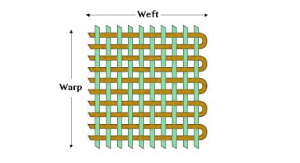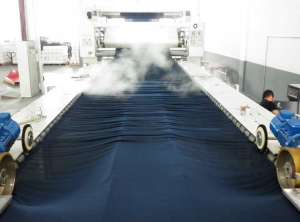Consumers, whether in the international or domestic market, are demanding more and more dimensional stability in garments. Especially in the international market, the special requirements of shrinkage prevention, superior shrinkage prevention and super shrinkage prevention are constantly put forward for fabrics. For the production of printing and dyeing enterprises, shrinkage is a nuisance.
Purpose of pre-shrinkage finishing
The purpose of fabric pre-shrinkage finishing is to make the fabric shrink a certain amount in the warp and weft direction in advance, so as to reduce the shrinkage rate of the final product and meet the quality requirements of garment processing.
During the dyeing and finishing process, the warp direction is subjected to tension, and the flexural wave height in the warp direction decreases, thus elongation occurs. When hydrophilic fibre fabrics are soaked with water, the fibre swells and the diameter of the warp and weft yarns increases, thus the warp yarns’ flexural wave height increases and the length of the fabrics is shortened, resulting in shrinkage. The percentage of the length shortening and the original length is called the shrinkage rate.
Physical methods to reduce the fabric shrinkage after immersion in order to reduce the shrinkage of the finishing process, also known as mechanical pre-shrinkage finishing. Compressive shrinkage is the fabric first by spraying steam or spray to the wet, and then applied to the warp direction of mechanical extrusion, so that the flexural wave height increases, and then by the loose drying. After pre-shrinkage of cotton fabric shrinkage can be reduced to less than 1%, and because of the fibres, yarns and yarns between the mutual extrusion and rubbing, the fabric feel of softness will also be improved.
Woollen fabrics can be used in relaxation pre-shrinkage treatment, the fabric by warm water immersion rolling or spraying steam, in the relaxed state of slow drying, so that the fabric warp and weft direction are contracted.
Fabric shrinkage and deformation in dyeing and finishing process
Fabrics in the weaving and dyeing and finishing process, usually the warp direction to withstand a strong mechanical tension, resulting in the occurrence of weft width contraction, warp elongation of the unstable state of the fabric. After the fabric is dipped and rolled, the length of the fabric will produce different degrees of contraction, and washing again will continue to produce subsequent contraction. Such as these fabrics cut clothing, after washing, due to fabric shrinkage and deformation of the clothes out of shape, which will cause great losses to consumers.
The best solution is to reduce mechanical tension in the process, the choice of tension-free loose mechanical processing, but from spinning, and weaving to printing and dyeing in a series of processes, to fully meet this requirement, is also impractical.
Measures to improve fabric shrinkage
It is in the final process of dyeing and finishing, trying to make the fabric warp yarns have the opportunity to retract, in order to restore the balance of the yarn bending state, to achieve the purpose of reducing shrinkage later.
How much does cotton shrink? Making the fabric after mechanical action and form stability with no deformation, is an economic work of great significance. This finishing method is called compressive shrinkage, which uses the equipment is compressive shrinkage machine or shrinking meter.
Causes of fabric shrinkage
Main reasons
- Due to the different tensions of the warp and weft yarns during processing, the bending degree of the warp and weft yarns will be different. After wetting and drying in a free state, the bending shape of the warp and weft yarns will be automatically restored to a balanced state, which is the so-called weaving shrinkage adjustment effect, resulting in the formation of shrinkage.
- Fibre in the wetting of anisotropic expansion, that is, the length and diameter of the fibre are increased, but the increase in diameter than the length of the degree of increase is much larger. Such as cotton fibres after wetting diameter increased by 14%, while the length of only 1.1% ~ 1.2%, so the fabric is wet, the fabric in the fibres due to expansion and thickening, but the length increase is not much, the yarn is bound to be thickened with the fibres and increase the diameter.
- The warp and weft yarns in the fabric are mutually embracing, such as the diameter of the weft yarn increases, and the length of the warp yarn must increase in order to maintain the state of embracing the weft yarn. But the warp yarn in the absence of increased external conditions, the length is impossible to grow. So the distance between the weft yarns will inevitably tighten, that is, the density of the weft yarn increases, resulting in the formation of fabric shrinkage in the warp direction. Weft yarns have the same phenomenon.
- When the fabric dries naturally, the fibre loses its expanded form, and the yarn returns to its original thickness. However, due to the friction resistance between the yarns, restricting the free movement of the yarns, the fabric still maintains the contraction form. So after the fabric is wetted and allowed to dry naturally, the area of the fabric tends to shrink, the thickness increases and the surface becomes uneven. Although the anisotropic expansion of fibres is one of the causes of fabric shrinkage, it is not a large percentage, so the cause of cellulosic fibre fabric shrinkage should be dominated by the adjusting effect of weaving shrinkage.
- Fabric shrinkage and fabric organisation and fibre properties have a great relationship. Such as warp density than the weft density of khaki, poplin and other fabrics, the weft shrinkage rate than the warp shrinkage is much smaller. Viscose and cotton are cellulosic fibres, but because of viscose fibre tissue structure is loose, the wet expansion rate is larger, and easy to stretch, more so in the wet state, so the viscose fabric shrinkage than cotton fabrics, that is, the use of mechanical pre-shrinkage of the entire method can not solve the problem of shrinkage. Generally have to use a chemical cross-linking method, to change the characteristics of viscose fibres, so as to solve the shortcomings of viscose fabrics shrinkage is too large.
Other reasons
When the fibres are spun, or when the yarn is being woven or dyed, the yarn fibres in the fabric are elongated or deformed by external forces. At the same time, the yarn fibres and the fabric structure generate internal stresses. In the static dry relaxation state, or in the static wet relaxation state, or in the dynamic wet relaxation state, or in the full relaxation state, the release of different degrees of internal stresses makes the yarn fibres and the fabric revert to the initial state.
What fabrics shrink? Does cotton shrink? For different fibres and their fabrics, the degree of shrinkage is different, mainly depending on the characteristics of the fibres – hydrophilic fibres shrink to a greater extent, such as cotton, linen, viscose and other fibres; and hydrophobic fibres shrink to a lesser extent, such as synthetic fibres.
Fibres in the wet state, due to the action of the soaking liquid to produce expansion, so that the diameter of the fibres become larger, such as in the fabric, forcing the fabric of the interweaving point of the fibre radius of curvature to increase, resulting in a shortening of the length of the fabric. For example, in cotton fibres in the role of water expansion, the cross-sectional area increased by 40 to 50%, the length increased by 1 to 2%, and synthetic fibres are heat shrinkage, such as boiling water shrinkage, generally about 5%.
Textile fibres are subjected to thermal conditions, the shape and size of the fibre change and contraction, cooling can not return to the initial state, known as fibre heat shrinkage. Heat shrinkage before and after the heat shrinkage of the length of the percentage known as heat shrinkage, generally to the boiling water shrinkage test, in 100℃ boiling water, the fibre length contraction of the percentage for the expression; also used in the hot air mode, in more than 100℃ in the measurement of the contraction of the percentage of hot air, but also used in the way of steam, more than 100℃ in the measurement of the contraction of the percentage of the vapour. Fibre due to the internal structure and heat temperature, time and other conditions are also different, such as the processing of polyester staple fibre boiling water shrinkage of 1%, polyvinyl chloride boiling water shrinkage of 5%, chlorine hot air shrinkage of 50%. Fibre in textile processing and the dimensional stability of its fabrics have a close relationship for the design of the latter process to provide some basis.
General fabric shrinkage rate:
- Cotton 4% – 10%
- Chemical fibre 4% – 8%
- Cotton polyester 3.5% – 5 5%
- Native white cloth 3%
- Wool blue cloth is 3-4%
- Poplin 3-4.5%
- floral cloth 3-3.5%
- Twill 4%
- Labour cloth 10%
- Rayon 10%
SmartShrink Shrinkage Rate Tester, a Smart Solution for calculating fabric shrinkage rate, can determine multiple shrinkage rate test results in 5 seconds and automatically measures fabric shrinkage and calculates the test results.
Mechanism of compressive shrinkage
The mechanical pre-shrinking treatment uses a compressible rubber blanket to carry fabrics for pre-shrinking. When the rubber blanket is curled under force, the outer arc elongates while the inner arc contracts, and if it is bent in the opposite direction, the elongated side becomes contracted while the contracted side elongates. Pre-shrinking treatment, containing a certain humidity of the fabric running close to the rubber blanket, through the compression zone, from the outer arc of the rubber blanket to the inner arc, i.e., from the stretching part of the contraction part, because the fabric by the rubber blanket and the pressure roller clamped and does not allow sliding, with the recovery of the rubber blanket contraction and compression, so that a certain contraction occurs.
Usually, the fabric is properly wetted (10%-15%) and heated before being put into the machine, so that the fibres become softer and have greater plasticity. There are also in the wet before (after finishing) by light pulp penetration or foam sizing, drying oven treatment to strengthen the pre-shrinkage control and improve the pre-shrinkage effect. When the fabric is pre-shrunk by rubber blanket, it is first pre-baked to remove part of the moisture, and then dried and ironed by the tension-free blanket dryer after leaving the machine, to eliminate the wrinkles produced by excessive shrinkage during compression, so as to obtain a plump hand feel and soft lustre.
Composition of compressive shrinkage machine
The main mechanism of the pre-shrinking finishing machine is a ring-shaped seamless felt or rubber blanket, which is wrapped around the fabric feed rollers, forming the stretching part of the elastic substance. The looped felt or rubber blanket is then wrapped around a large heated dryer or pressure roller.
At this time the original cloth roller was stretched felt or rubber blanket, to the big roller, that is, transformed into a contracted state, felt or rubber blanket surface that is from the outer edge of the arc into the inner edge of the arc, so that tightly pressed on the felt or rubber blanket on the fabric at the same time also received the effect of compression, the moisture on the fabric and the electric heating boots and big drying cylinder or the pressure roller on the heat, you can increase the plasticity of the fibre, thus enhancing the compression of the fabric.
Taking the rubber blanket pre-shrinking machine as an example, when the rubber blanket around the cloth around the roller and pressure roller, is a part of the rubber blanket surface elongation, the other part of the contraction, wrapped in the cloth to the rubber blanket on the stick a section, the surface is elongated, in the pressure roller on the a ‘section, the surface is contracted. During operation, from section a to section a’, the surface of the rubber blanket changes from elongation to contraction. b and b’ are located in the middle of the rubber blanket, so the length of section b’ is constant, i.e., b=b’.
In the cloth roller when a>b, and to the pressure roller, it becomes a'<b’. At the same time the rubber blanket by the cloth roller and pressure roller rolling, part of the compression effect by the violent, to the S point, the rubber blanket only gradually returned to the original thickness, so there is a backward extrusion reaction force F, to the direction of the pressure roller extrusion, which results in increased compression effect on the fabric. The action of heat strengthens the plasticity of the fibre, which is more conducive to contraction.
The pre-shrunk fabric should therefore be pulled away from the rubber blanket as soon as it leaves the pressure roller, so that it is no longer in contact with the rubber blanket. As the rubber blanket is stretched on the guide rolls behind it, the fabric will be stretched again and the pre-shrinking effect will be eliminated if the fabric is still tightly attached to the rubber blanket.
Compressive shrinkage is to use mechanical and physical methods to improve the weaving shrinkage of the warp yarns in the fabric. Due to the processing in the previous process, the fabric warp is often stretched state, resulting in the consequences of the warp yarn in the fabric stretched too straight, that is, the warp yarn weaving shrinkage than the normal state of low, mechanical pre-shrinkage is to solve or improve the warp yarn weaving shrinkage of the abnormal state. In other words, it is to solve or improve the warp shrinkage problem of the fabric.
Key points of the pre-shrinkage finishing process
- The pre-shrinkage treatment must maintain three stability.
- The speed of the pre-shrinking machine remains stable.
- The moisture return rate of the fabrics entering the rubber blanket unit should be kept stable.
- The steam pressure of the pressurised dryer in the rubber blanket unit remains stable.
Processing, must be done on the fabric shrinkage rate monitoring mark, check, check the fabric pre-shrinkage rate, found that the problem should be promptly adjusted to ensure that the shrinkage rate is stable. In the pre-shrinkage equipment operation process, must strengthen the personnel operation management and equipment management, in order to prevent defects, and at the same time also master the defects of the solution to reduce the defect rate.
Problems and solutions
The problems of pre-shrinking finishing are fish scale, warp crease, rolling wrinkle, weft slant, wet drop cloth, insufficient shrinkage rate, narrow door width and so on.
- Fish scale spot
The rubber blanket part of the ageing and fabric pre-shrinkage is caused by uneven. Grind or replace the ageing rubber or carpet that has been defective.
- Warp crease
Due to the pre-shrinkage, the fabric has to wrinkle or fabric into the pre-shrinking machine when the warp tension is too large. In the pre-processing process, pay attention to prevent the production of warp folding, that is, pre-shrinking can relax the taut fabric frame, and reduce the warp tension, in order to solve the problem of warp folding.
- Rolling wrinkles
The cloth tension is too small, the cloth surface is too loose, the cloth roller pressure is not equal to the left and right, the blank cloth edge is too loose or the two sides of the edge of the mouth the unevenly tightening and so on can be caused by the rolling of wrinkles. You can adjust the taut cloth frame to increase the cloth feeding tension and adjust the cloth feeding roller to keep the pressure uniform on both sides.
- Weft slanting
The causes are incorrect feeding position, uneven cloth guide roller, uneven pressure on both sides of the cloth feed roller. Processing should be placed in the right position, to ensure that the cloth guide roller is straight, and adjust the pressure, so that the pressure on both sides of the cloth roller is uniform.
- Drop cloth wet
Due to the fabric in the process of excessive wetting. Therefore, in the pre-shrinkage process, to control the amount of spray and running speed, you can reduce the speed, in order to make the cloth fully dry.
- Insufficient shrinkage
The pre-shrinkage effect is not good, with poor dimensional stability. This is due to the pressure roller position being too high, the pressure roller temperature being too low, the cloth roller pressure is not enough, the in and out of the cloth tension being too large and other reasons. It can reduce the position of the pressure roller, control the spray to wet, improve the steam pressure of the pressure roller, increase the pressure of the fabric roller, and reduce the tension of inlet and outlet fabric.
- Narrow door width
Due to the processing of the previous process caused by pre-shrinking before the door width is not enough, or pre-shrinking into the fabric tension is too large, resulting in fabric pre-shrinking after the narrow door width. The previous processing procedures should be in strict accordance with the technology to ensure that the width of the fabric meets the requirements; at the same time in the pre-shrinking process, pay attention to reducing the appropriate tension in the fabric.




